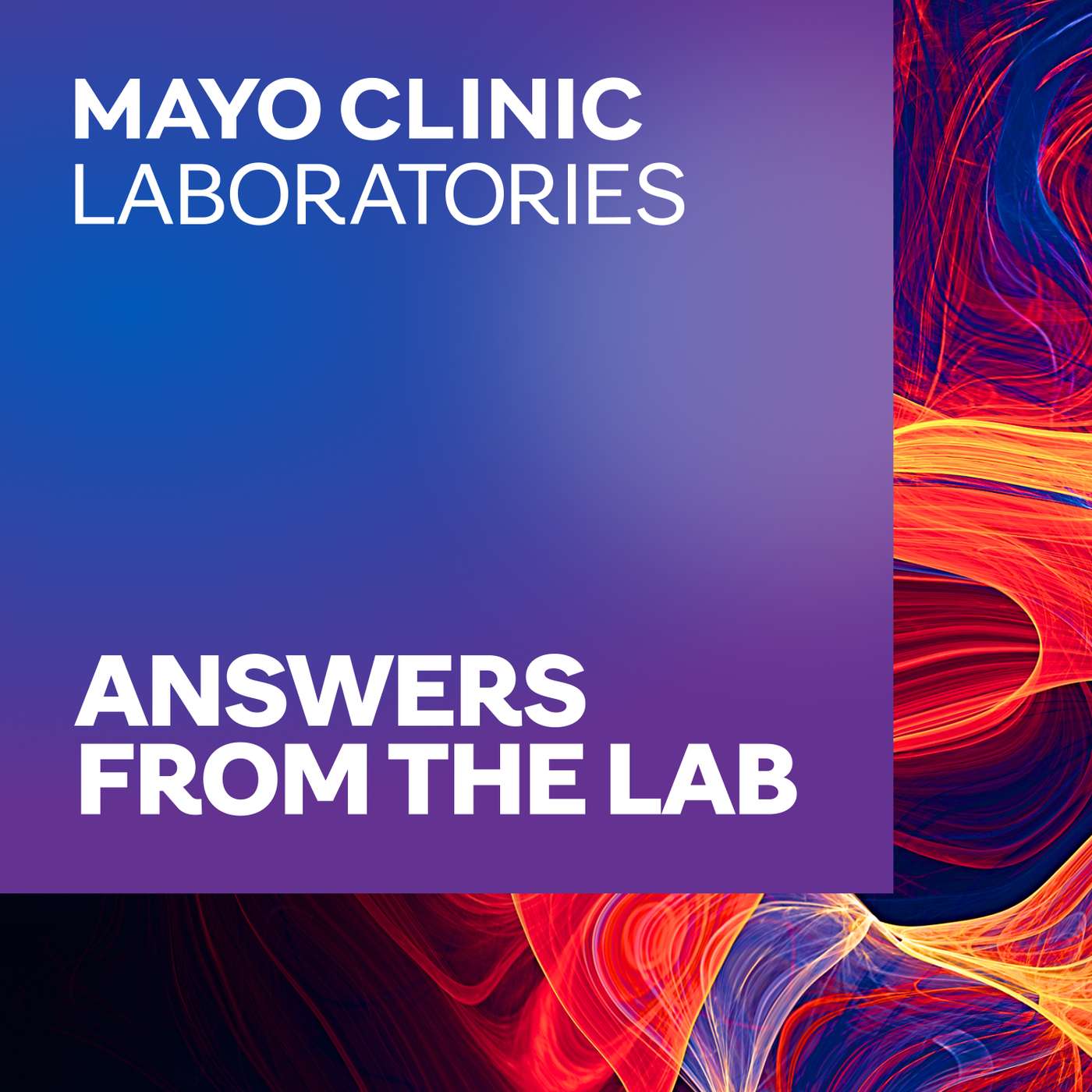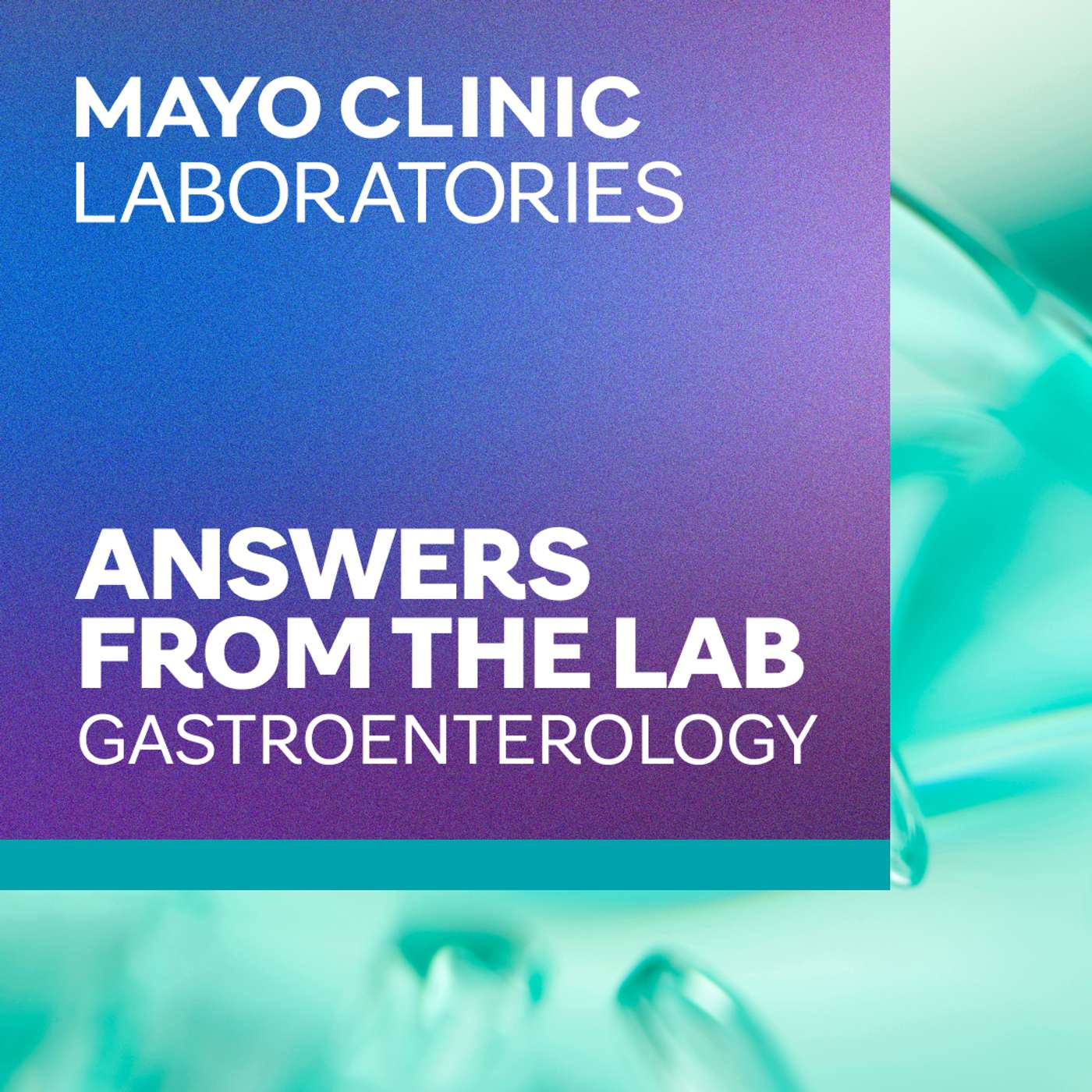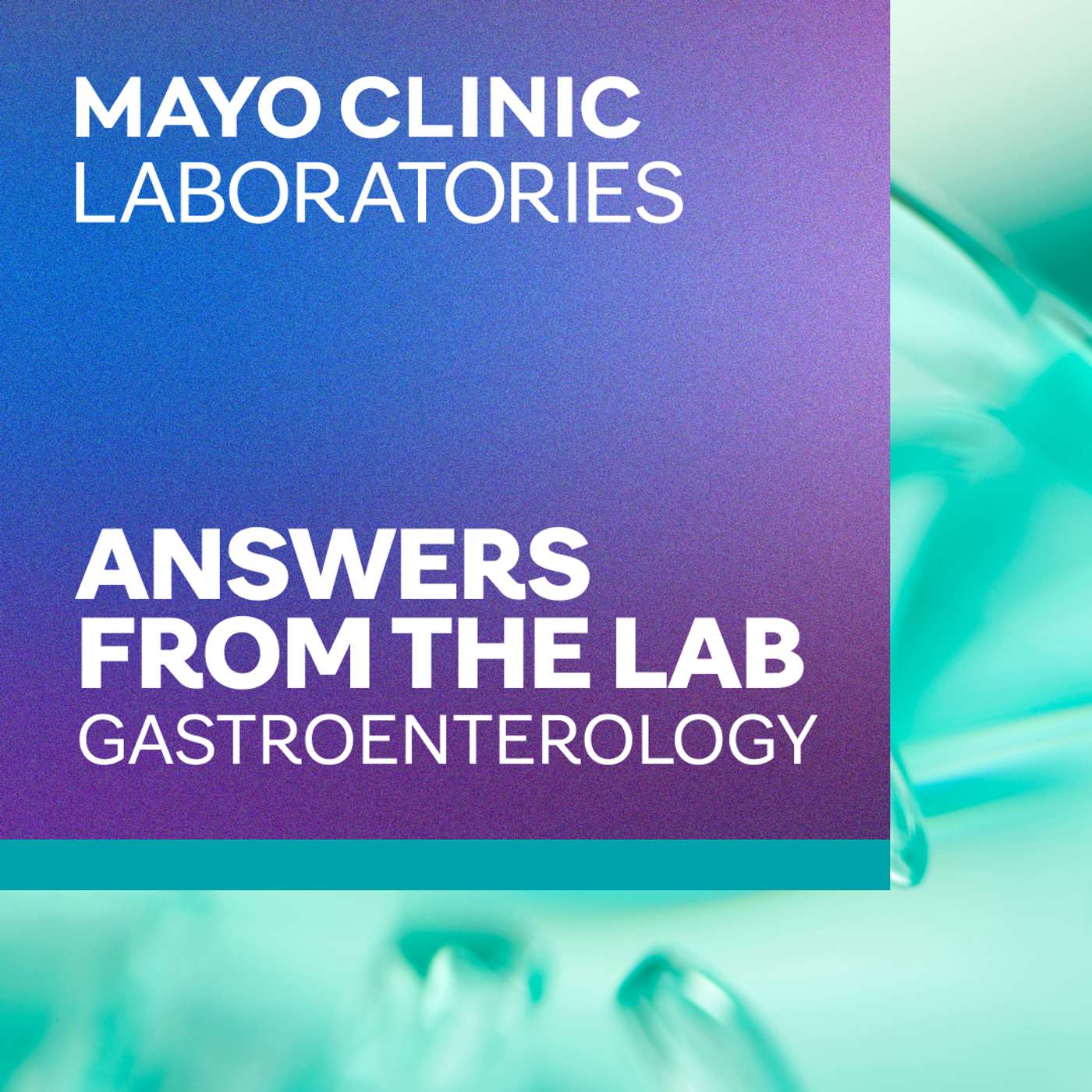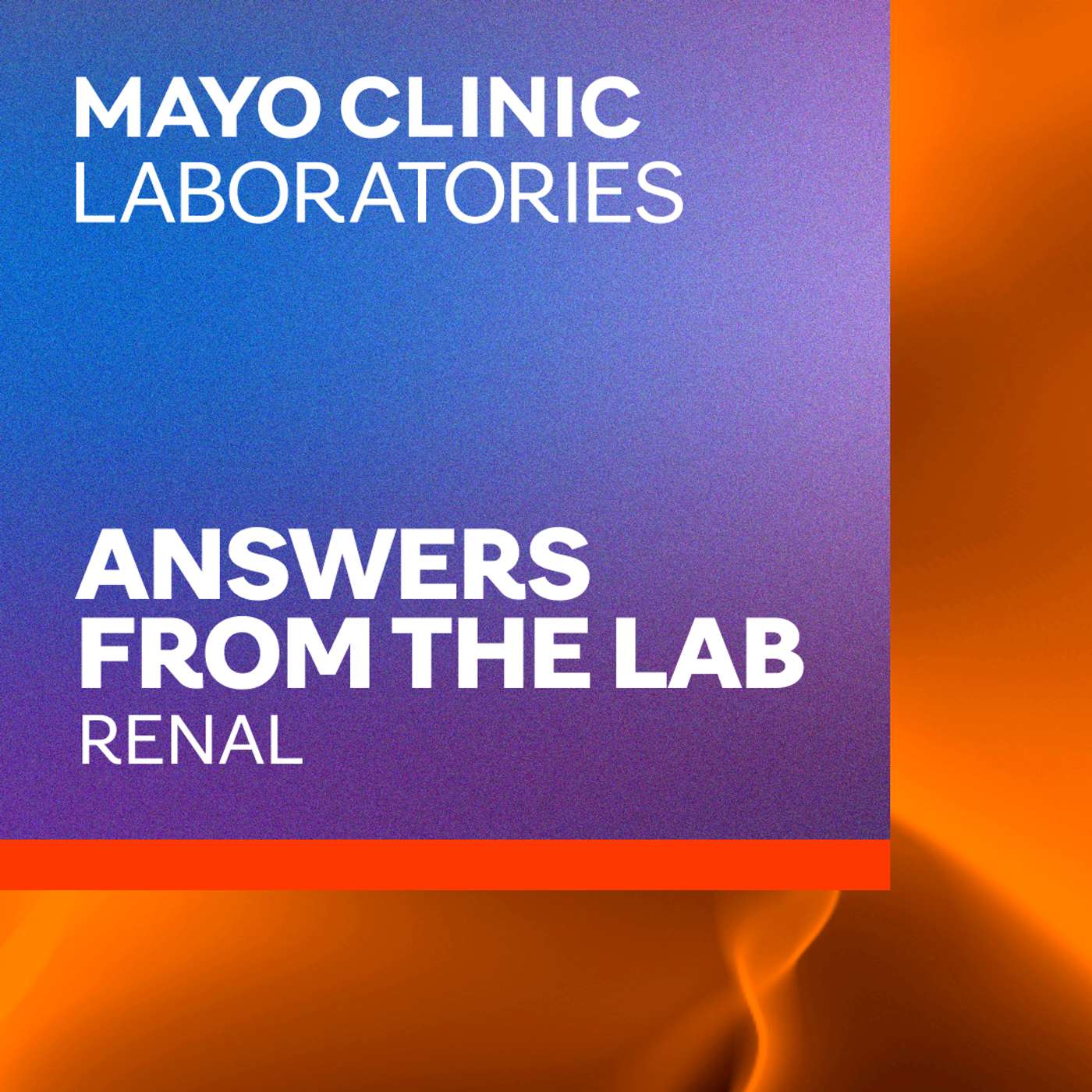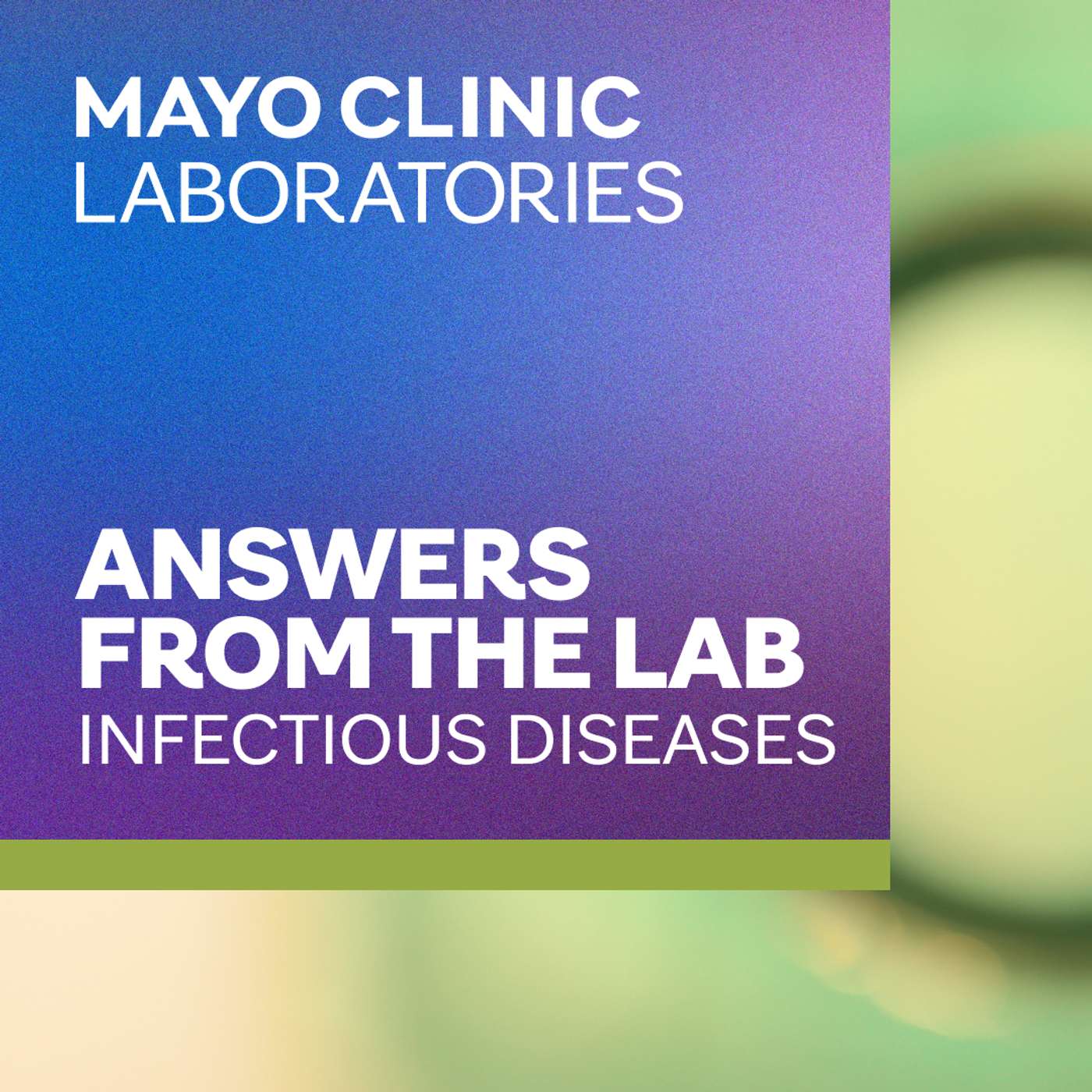Discover Answers from the Lab
Answers from the Lab

Answers from the Lab
Author: Mayo Clinic Laboratories
Subscribed: 66Played: 2,992Subscribe
Share
© 2022 Mayo Foundation for Medical Education and Research. All rights reserved.
Description
A Mayo Clinic curated podcast sharing Mayo Clinic knowledge and advancements on the state of testing, science, and people who are making it happen behind the scenes.
370 Episodes
Reverse
In this episode of “Answers From the Lab,” host Bobbi Pritt, M.D., chair of the Division of Clinical Microbiology at Mayo Clinic, is joined by William Morice II, M.D., Ph.D., president and CEO of Mayo Clinic Laboratories, to discuss recent news about Protecting Access to Medicare Act (PAMA) reform. Then, Dr. Pritt welcomes Trish Simner, Ph.D., a clinical microbiologist at Mayo Clinic, for an in-depth conversation about metagenomics. PAMA reform update and new RESULTS Act (00:30): Hear about options under consideration for PAMA reform, including the Reforming and Enhancing Sustainable Updates to Laboratory Testing Services (RESULTS) Act.When cerebrospinal fluid (CSF) metagenomics benefit patient care (06:04): Explore how CSF metagenomics work and when it is appropriate to use this advanced diagnostic tool in clinical practice.Advancement and innovation in metagenomics (18:15): Discover how recent and upcoming innovation is expanding metagenomic testing capabilities. Note: Information in this post was accurate at the time of its posting.ResourcesAnswers From the Lab podcast: Developments for LDT Regulation and Laboratory Reimbursement: Bill Morice, M.D., Ph.D.Metagenomics: Identifying elusive pathogenic microorganisms
In this episode of “Answers From the Lab,” host Bobbi Pritt, M.D., chair of the Division of Clinical Microbiology at Mayo Clinic, welcomes William Morice II, M.D., Ph.D., president and CEO of Mayo Clinic Laboratories. Together, they discuss recent news about virus activity and explore the value of collaboration in shaping innovative diagnostic strategies. Testing for viruses appearing closer to home (00:45): Gain insights on using available testing to manage measles and detect chikungunya, which was recently transmitted in the U.S. for the first time in years. Collaborating for more coordinated care and innovation (06:04): Explore how strategic partnerships in diagnostics foster innovation and enable a more integrated approach to clinical decision-making.Building successful collaborations (12:16): Discover practical insights into establishing and maintaining collaborations that deliver meaningful value to all involved. Note: Information in this post was accurate at the time of its posting.ResourcesAnswers From the Lab Podcast: How the Evolving Role of Diagnostics and Platforms Impact Healthcare: Bill Morice, M.D., Ph.D. Dr. Bill Morice shares how a platform for collaboration transforms diagnosticsMary Jo Williamson offers four steps to maximize collaboration benefits
In this episode of “Answers From the Lab,” host Bobbi Pritt, M.D., chair of the Division of Clinical Microbiology at Mayo Clinic, is joined by William Morice II, M.D., Ph.D., CEO and president of Mayo Clinic Laboratories, to discuss recent news about drug-resistant infections. Later, Paul Jannetto, Ph.D., director of the Clinical and Forensic Toxicology Lab, Clinical Mass Spectrometry Lab, and Metals Lab, joins Dr. Pritt for the deep dive segment. Together, they explore how diagnostics are shaping the future of therapeutics. New podcast format launch (00:25): Drs. Morice and Pritt introduce the exciting new format for “Answers From the Lab,” including the addition of in-depth expert segments. Drug-resistant infections (02:05): Discover how clinical diagnostics play a critical role in combating the growing threat of antibiotic resistance. Diagnostics’ role in advancing precision medicine (13:28): Learn how diagnostics, specifically drug monitoring, are advancing personalized therapies and contributing to better outcomes. Note: Information in this post was accurate at the time of its posting. Resources Therapeutics testing: A clear path to accurate answers Therapeutics testing at Mayo Clinic Laboratories WHO warns of widespread resistance to common antibiotics worldwide Tests for infectious disease detection and identification Connect with Us Is there a question or topic you’d like us to explore in a future episode? Email us at mayocliniclabs@mayo.edu. Learn more about our hosts and guests and connect with them on social media. Bobbi Pritt, M.D. Bio | LinkedIn Bill Morice, M.D., Ph.D. Bio | LinkedIn Paul Jannetto, Ph.D. Bio | LinkedIn
Published October 16, 2025 In this episode of “Answers From the Lab,” host Bobbi Pritt, M.D., chair of the Division of Clinical Microbiology at Mayo Clinic, and William Morice II, M.D., Ph.D., CEO and president of Mayo Clinic Laboratories, discuss recent regulatory and policy developments. Together, they explore:FDA rescinds rule on LDTs (00:48): The FDA has officially withdrawn its rule that would allow oversight of laboratory-developed tests (LDTs) as medical devices. The conversation explores what this decision means and what might come next for LDT regulation.PAMA reform update and new RESULTS Act (05:13): The newly introduced Reforming and Enhancing Sustainable Updates to Laboratory Testing Services (RESULTS) Act aims to address reimbursement for laboratory tests.Getting engaged (12:37): Why it is important to understand new regulatory policies and help others understand their implications for the industry.ResourcesFind past “Answers From the Lab” podcasts on LDTs and PAMA
Published October 2, 2025 In this episode of “Answers From the Lab,” host Bobbi Pritt, M.D., chair of the Division of Clinical Microbiology at Mayo Clinic, and Elitza Theel, Ph.D., director of the Infectious Diseases Serology Laboratory at Mayo Clinic, discuss the latest developments in self-collection testing for women’s health and beyond. Together, they explore:New podcast format launching (00:01): Dr. Pritt previews exciting changes coming to “Answers From the Lab.” Emerging self-collection tests (01:21): Explore the growing range of self-collection tests now available for use in both clinical settings and at home.Validation of self-collection tests (03:19): Learn how laboratorians validated recent self- and home-collection tests to ensure quality and accuracy. Benefits for patients and public health (06:56): Understand the benefits self-collection tests offer to patients and how the tests impact public health.Limitations and implementation considerations (08:23): Review key factors to consider when incorporating self-collection testing into clinical care.Future innovation (11:34): Insights into where self-collection testing may evolve in the years ahead.
Published September 11, 2025 In this episode of “Answers From the Lab,” host Bobbi Pritt, M.D., chair of the Division of Clinical Microbiology at Mayo Clinic, and William Morice II, M.D., Ph.D., CEO and president of Mayo Clinic Laboratories, discuss troublesome organisms making headlines. Together, they explore:Vibrio vulnificus (01:09): How people get this “flesh-eating” bacteria, how it affects patients, and a recent case that brought it into the spotlight.Staying safe (03:44): Discover when to seek medical attention and how knowledge can protect you as Vibrio vulnificus bacterium becomes more prevalent. New World screwworm (06:50): How this parasitic infection damages human tissue, how it was previously eradicated, and why it's making the news again. ABCs of protection (12:16): A simple reminder to avoid exposure, use bug spray, and wear protective clothing to shield against hazardous organisms.Laboratory as first line of defense (13:34): Laboratorians have a critical role in identification and monitoring broader trends when these types of cases arise. ResourcesA-Zs for prevention and exposure risks
Cherisse Marcou, Ph.D., and Kristen Rasmussen, M.S., CGC, explain how Mayo Clinic Laboratories' WESPR whole exome sequencing reflex test provides cost-effective diagnosis of complex genetic conditions. Using samples and data from previous targeted gene panels, WESPR's wider net can identify undetected genetic variants.(00:32) Would each of you share a little bit about yourselves and your background? (01:42)Could you provide us with an overview of the whole exome reflexing panel? (02:53) Is this different from our whole exome sequencing panel and our whole exome reanalysis panel? (04:00) Tell us more about who benefits from this test. (06:17) What is the clinical utility of this testing? (08:07)Would you help providers understand how to go about ordering? (11:23)Could you tell us more about the types of variants identified by this test? (13:39)Based on those performance characteristics, how does our test match up to other exome tests available in the market? (14:30)Are there any other unique features you would like to highlight? (15:57)What is the turnaround time for the reflex panel? (16:14)Can the results from the WESPR test be reanalyzed in the future as new genetic knowledge emerges? (16:56)How are variants reported, especially variants of uncertain significance? And does the report include recommendations? (19:31)Would you summarize the benefits of the WESPR at Mayo Clinic Laboratories?
Published August 28, 2025 In this episode of “Answers From the Lab,” host Bobbi Pritt, M.D., chair of the Division of Clinical Microbiology at Mayo Clinic, and Matthew Binnicker, Ph.D., a microbiologist and virologist and chief scientific officer of Mayo Clinic Laboratories, discuss recent developments in viral infections. Together, they explore:Shope papilloma virus in rabbits (01:05): Unusual growths raise concern, though the virus poses minimal risk to humans and has actually benefitted research for other papilloma viruses. Chikungunya virus (07:07): What it is, how it spreads, who is at risk, and best practices for testing. Back-to-school viral trends (12:19): Common viruses that circulate during the school season, tips for keeping kids safe, and guidance for physicians on when to test. The laboratorian’s role (18:27): How laboratory professionals contribute to managing viral infections within hospital systems and the broader community.ResourcesForbes article: Is the ‘zombie rabbits’ virus a threat to humans?Mosquito-borne disease testing overviewMosquito-borne testing algorithms and interpretationsSearch our test catalog for more on testing for viral infections
Published August 14, 2025 In this episode of “Answers From the Lab,” host Bobbi Pritt, M.D., chair of the Division of Clinical Microbiology at Mayo Clinic, and William Morice II, M.D., Ph.D., CEO and president of Mayo Clinic Laboratories, discuss recent news about the use of artificial intelligence (AI) tools in healthcare. Together, they explore:Applications of AI tools in clinical diagnostics to identify dementia, cardiovascular conditions, and parasites.Ethical considerations, including global disparities in access to AI tools and environmental impacts.ResourcesUse of artificial intelligence and digital slide scanning for detection of intestinal protozoa in trichrome-stained stool specimensMayo Clinic's AI tool identifies 9 dementia types, including Alzheimer's, with one scanAI computing power is splitting the world into haves and have-nots - The New York Times
In this episode of “Answers From the Lab,” host Bobbi Pritt, M.D., chair of the Division of Clinical Microbiology at Mayo Clinic, is joined by Elitza Theel, Ph.D., director of the Infectious Diseases Serology Laboratory at Mayo Clinic, for a timely discussion on tick-borne diseases. Topics covered include:Observations from this year’s tick season as we approach the end of July — a peak month for tick-borne disease transmission — along with trends in reported tick-borne pathogens over the past two decades.Algorithms developed by Mayo Clinic to guide clinicians in selecting the right tests for tick-borne and mosquito-borne diseases. The emergence of rare and esoteric infections and the challenges posed by vectors that carry and transmit multiple pathogens in a single bite.Shotgun metagenomics’ growing role in the diagnosis of vector-borne infections.More resources Read "Update on North American tick-borne diseases and how to diagnose them" in the Journal of Clinical Microbiology for more insights from Drs. Pritt and Theel. You can also explore tools and information from Mayo Clinic Laboratories, including region-specific details, algorithms, prevention tools, and more.
In this episode of “Answers From the Lab,” host Bobbi Pritt, M.D., chair of the Division of Clinical Microbiology at Mayo Clinic, and William Morice II, M.D., Ph.D., CEO and president of Mayo Clinic Laboratories, discuss summertime illnesses and key insights from a recent diagnostic investment event. Together, they explore:Common summertime illnesses, along with tips for prevention. How investment in diagnostic tools influences innovation in the laboratory.The potential impact of growing interest in AI investments. The investment interest in liquid biopsy and its potential implications for clinical decision-making.How AI development may accelerate adoption of mass spectrometry, proteomics, and similar advancements in clinical laboratories.
Linda Hasadsri, M.D., Ph.D., and Huong Cabral, M.S., CGC, explain how Mayo Clinic Laboratories' expanded test panel captures rarer as well as more common genetic causes of hereditary pancreatitis. That information is key to managing patients' enhanced risk for pancreatic cancer.(00:32) Could you both please tell us a little bit about yourself and your background? (02:23) Could you please give the audience a brief overview of this assay? (03:53) Which patients should have this test, and when should it be performed? (04:49) What alternative testing options are available, and how do these compare to the new, expanded panel that we're going to be offering? (08:20)How are the results used in patient care?
In this episode of “Answers From the Lab,” host Bobbi Pritt, M.D., chair of the Division of Clinical Microbiology at Mayo Clinic, and William Morice II, M.D., Ph.D., CEO and president of Mayo Clinic Laboratories, share insights from industry news and recent conferences, including PlatforMed. They explore:The significant interest in diagnostics for the advancement of cancer care.The Joint Commission’s collaboration with the Coalition for Health AI to establish guidelines for the responsible use of artificial intelligence. The growing understanding that platforms offer an opportunity to expand access and make knowledge more accessible as platform-driven solutions become a reality.The role of laboratorians in guiding the ethical and effective use of data and emerging technologies — and what this means for educating future healthcare professionals.The critical importance of values and ethics in deploying new tools.
Joshua Bornhorst, Ph.D., explains how Mayo Clinic Laboratories' labile copper assay (Mayo ID: LBCS) improves upon standard blood tests for Wilson's disease. The new test measures not just overall copper but also the fraction of copper that is bioavailable, or labile bound.(00:32) Can you tell us a little bit about yourself and your background? (01:33) Could you give us a brief overview of this assay? (02:47) Which patients should have this testing, and when should it be performed? (03:48) How would the results be used in patient care?
John Lieske, M.D., and Sandra Taler, M.D., explain how Mayo Clinic Laboratories' mass spectrometry assay helps evaluate patients for resistant hypertension. The test detects antihypertensive medications in urine, providing evidence of whether patients are absorbing their medications or whether a new treatment approach might be needed. Speaker 3: (00:33) Could you tell us a little about yourselves and your backgrounds? Speaker 3: (01:41) Dr. Taler, could you provide us with a brief background on resistant hypertension? Speaker 3: (03:43) Can you provide a little bit more background on patients who aren't taking their medications? Speaker 3: (05:11) How do physicians currently assess whether patients are taking their medications? Speaker 3: (07:03) Dr. Lieske, could you tell us how this new assay can be used to help physicians manage their patients with hypertension? Speaker 3: (09:43) Dr. Taler, can you tell us how doctors can use this new testing to manage their patients?
In this episode of “Answers From the Lab,” host Bobbi Pritt, M.D., chair of the Division of Clinical Microbiology at Mayo Clinic, and Div Dubey, M.B.B.S., a neurologist and co-director of the Clinical Neuroimmunology Laboratory at Mayo Clinic, explore the topic of peripheral neuropathy. Their discussion covers:The high prevalence of peripheral neuropathy and why early diagnosis is important. The complexities involved in diagnosing the condition.Symptoms that should prompt clinicians to order advanced testing early in the diagnostic process.How algorithms are enhancing the use of testing to complement other diagnostic tools.Ongoing discovery related to specific antibodies associated with neuropathies.Learn more in our e-book, "Peripheral neuropathy: Cutting through diagnostic dissonance with an algorithmic approach."
Joseph Yao, M.D., explains how Mayo Clinic Laboratories' new quantitative assay (Mayo ID: ADVQU) goes beyond qualitative testing to evaluate transplant patients for adenovirus infection. Adenovirus can cause life-threatening disease in immunocompromised transplant patients, especially children.(01:14)Could you give us a brief overview of this assay? (02:06)Can you explain the differences of the qualitative and quantitative methods and why we made the change to a quantitative adenovirus method? (04:00)When is this test typically ordered for transplant patients? Is it used throughout their treatment? (06:56)Could an immunocompromised person be unknowingly infected? (07:31)Is our quantitative method approved for pediatric patients? (08:00)How are the test results used to treat patients?(10:36)What other infections might providers consider alongside adeovirus?
In this episode of “Answers From the Lab,” host Bobbi Pritt, M.D., chair of the Division of Clinical Microbiology at Mayo Clinic, and William Morice II, M.D., Ph.D., CEO and president of Mayo Clinic Laboratories, discuss global trends in diagnostic manufacturing and their implications for laboratory professionals. Topics include: Emerging innovations in mass spectrometry, next-generation sequencing, automation, and artificial intelligence. Fierce competition in the global manufacturing landscape as new companies enter the market. Geopolitical dynamics influencing where innovations are deployed. Why laboratory professionals need to drive innovation implementation to maximize benefits for clinicians and their patients.
In this episode of “Answers From the Lab,” host Bobbi Pritt, M.D., chair of the Division of Clinical Microbiology at Mayo Clinic, is joined by William Morice II, M.D., Ph.D., CEO and president of Mayo Clinic Laboratories, to discuss the value laboratories deliver for their entire health system. They cover how laboratories impact:Growth in revenueGrowth in lab chargesGrowth in ancillary servicesHospital length of stayControl over expensesYou can also find more in-depth information on this topic in “Maximizing your health system’s financial performance,” a white paper with data-driven ways laboratories support their organizations.
In this episode of “Answers From the Lab,” host Bobbi Pritt, M.D., chair of the Division of Clinical Microbiology at Mayo Clinic, is joined by William Morice II, M.D., Ph.D., CEO and president of Mayo Clinic Laboratories, to discuss tick-borne diseases. They cover:Different diseases patients can get from ticks. Disease prevention, including Dr. Pritt’s A through Z flash cards with tips for people to protect themselves from infectious insects.Laboratory medicine’s valuable role in testing and educating providers to diagnose patients quickly and accurately.Clinical areas most likely to encounter patients with tick-borne diseases.Reliable sources for details about the prevalence of different diseases around the country (e.g., U.S. Centers for Disease Control and Prevention (CDC) and Mayo Clinic Laboratories).




